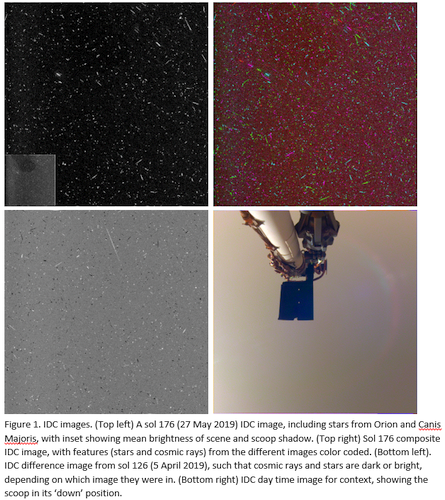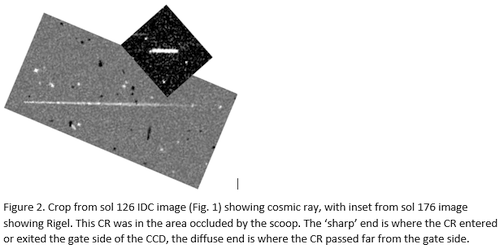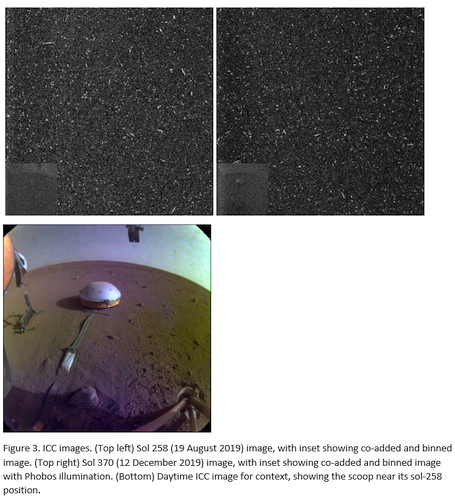The InSight Mars lander’s meteor search
- 1Space Science Institute, Boulder, CO, USA (mlemmon@spacescience.org)
- 2Brown University, Providence, RI, USA
- 3Goddard Space Flight Center, Greenbelt, MD, USA
- 4Obervatoire de Paris, Meudon, France
- 5Curtin University, Perth, WA, Australia
- 6Jet Propulsion Lab, Pasadena, CA, USA
The InSight lander (Banerdt et al. 2020) on Mars is equipped with two cameras capable of sky imaging both of which have been used opportunistically to search for meteors. The rate of occurrence of Martian meteors has not been directly measured and initial reports of an imaged meteor by Selsis et al. 2005 were likely incorrect (Domokos et al. 2007). The meteor search is part of the investigation into the flux of impactors at Mars (Daubar et al. 2018).
The InSight cameras have been described by Maki et al. (2018). The Instrument Deployment Camera (IDC) can be aimed by a robotic arm and has a 45-degree square field of view (FOV). However, this camera was typically unavailable, and has only been used twice. The Instrument Context Camera (ICC) has a 120-degree fisheye FOV. It is aimed downward, but sees a broad section of the southern sky to around 20-degrees elevation angle.

IDC images are shown in Fig. 1. They were aimed to the southwest at an elevation of about 35 degrees, and on sols 126 and 176 (5 April and 27 May 2019), four 5-minute exposures were acquired. Stars are visible in the images, and will be used to determine the sensitivity. Many cosmic rays were seen (e.g., Fig. 2)—long ones can be mistaken for meteors, but they have a distinctive morphology with a narrow end and a diffuse end due to the charge diffusion process after the charged particles pass through the detector (Fisher-Levine and Nomerotski, 2015). Despite the Sun being 60 degrees down, diffuse sky brightness was visible (Banfield et al. 2020). No meteors were detected.

ICC images are shown in Fig. 3—about 75% of the images do not include sky. On 25 sols from 254 to 432 (15 August 2019 to 6 February 2020), the ICC acquired four, 5-minute exposures. No meteors were seen.
We will present an analysis of the results and their implication for the meteor rate at Mars. While no meteors were seen, the upper limit is likely to be constraining. Total exposure time is 540 minutes, using cameras more sensitive than the limiting exposures of Domokos et al. (2007) and with wider FOVs. However, the complex geometry and the time variable atmospheric dust extinction will be considered.

References. Banerdt et al. 2020. Nature Geoscience, 13, 183-189. Banfield et al. 2020. Nature Geoscience, 13, 190-198. Daubar et al. 2018. Space Science Rev. 214, 132. Domokos et al. 2007. Icarus 191, 141-150. Fisher-Levine and Nomerotski 2015. BNL-108381-2015-JA. Maki et al. 2018. Space Sci. Rev. 214, 105. Selsis et al. 2005. Nature 435, 581.
How to cite: Lemmon, M., Daubar, I., Banks, M., Vaubaillon, J., Sansom, E., and Maki, J.: The InSight Mars lander’s meteor search, Europlanet Science Congress 2020, online, 21 September–9 Oct 2020, EPSC2020-499, https://doi.org/10.5194/epsc2020-499, 2020

